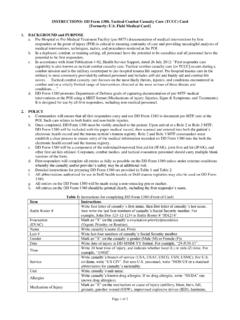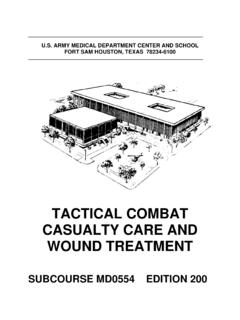Transcription of THE COMMITTEE FOR TACTICAL EMERGENCY CARE (C-TECC ...
1 Journal of Special Operations Medicine Volume 11, Edition 2 / Spring 1194 THECOMMITTEE FORTACTICALEMERGENCYCARE (C-TECC ): EVOLUTION ANDAPPLICATION OFTCCC GUIDELINES TO CIVILIAN HIGH THREAT MEDICINEC allaway, DW; Smith, ER; Shapiro, G; Cain, JS; McKay, SD; Mabry, RLCORRESPONDINGAUTHORD avid W. Callaway, MDDirector, The Operational Medicine Institute (OMI)Associate Professor of EMERGENCY MedicineCarolinas Medical Center1000 Blythe BlvdCharlotte, NC 28203 AUTHORSE. Reed Smith, MDOperational Medical DirectorArlington County Fire DepartmentAssistant Professor of EMERGENCY MedicineThe George Washington UniversityAddress is 1020 North Hudson Street, 3rd FloorArlington, VA 22201 Sean D. McKay, EMT-PAssociate, Asymmetric combat Institute (ACI)115-136 Wade Hampton , SC 29687 INTRODUCTIONThe COMMITTEE for TACTICAL EMERGENCY casualty care (C-TECC) was convened to expedite the appropriatetransition of military medical lessons learned from the battlefield to civilian crisis response in order to reduce preventa-ble causes of death in both our first responders and civilian population ( Appendix 1: Mission Statement).
2 The Committeefor TACTICAL EMERGENCY casualty care (C-TECC) is modeled after the COMMITTEE for TACTICAL combat casualty care (CoTCCC) and is comprised of a broad range of interagency operational and academic leaders in the practice of high threatmedicine and fire/rescue from across the nation, including members from EMERGENCY medicine, EMERGENCY medical serv-ices, police, fire, and the military Special Operations community. C-TECC remains an independent civilian entity, butmaintains a close relationship with CoTCCC for guidance and Shapiro, EMT-PCoordinator, Operational Medicine ProgramsThe George Washington University2131 K Street, NW Suite 510 Washington, DC 20037 Jeffery S. Cain, MDMedical Director, McKinney SWAT2804 Atwood DriveMcKinney, TX 75070 Robert L. Mabry, MDUnited States ArmyInstitute of Surgical Research3400 Rawley E, Chambers AveFort Sam Houston, TX 78234C-TECC Stand Up95 The TACTICAL EMERGENCY casualty care (TECC) guidelines are a set of best practice recommendations for casualtymanagement during high threat civilian TACTICAL and rescue operations.
3 The TECC guidelines are based upon the principlesof TACTICAL combat casualty care (TCCC) but account for differences in the civilian environment, resources allocation, pa-tient population, and scope of practice. BACKGROUNDWar and conflict drive advances in trauma care . Historically, the gap in this knowledge transference from the bat-tlefield to the civilian medical setting is significant, up to 10 years by some accounts. However, throughout the currentOIF/OEF conflict, extensive and aggressive medical data collection coupled with advanced technology has allowed for morerapid integration of these lessons learned. To date, this important practice evolution has been seen to some extent in civil-ian trauma centers, but only small advances, mostly in an ad hoc fashion, have been appearing in the prehospital TACTICAL EMERGENCY Medical Support (TEMS) has a long and storied history in the United States.
4 During the lastdecade, enormous progress has been made in developing professional and operational standards within the field. However,to date, there still exists no standard of care within the TEMS specialty. Additionally, current civilian first responder prac-tices and principles do not adequately address the need for point of wounding care in atypical EMERGENCY response. Ratherthey continue to emphasize only scene safety and casualty evacuation without care rendered. These same gaps existed in military operations as well prior to the mid-1990s. In response to operations in Soma-lia, medical providers within various military Special Operations Forces (SOF) examined the causes of combat related deathsas well as the manor in which medical care was being delivered in the field. The conclusion was that the broad applicationof civilian trauma principles in combat often negatively affected mission success and appropriate casualty care .
5 As notedby Capt. Frank Butler, Good medicine often was bad tactics. And, bad tactics get people killed. 1 This deficiency led tothe creation of the doctrine of TACTICAL combat casualty care (TCCC) within the Special Operations community. 2-4 Over the past decade of war, TCCC has expanded from SOF into the conventional military population and is nowconsidered the standard of care for prehospital trauma care on the CoTCCC process and TCCC guidelineshave been credited with reducing the case fatality rate (CFR) in current combat operations from approximately 14% in Viet-nam to during ,7 The proven success of TCCC has led the civilian medical community, both TACTICAL and conventional, to examineclosely the tenants of the TCCC doctrine and integrate portions into civilian trauma care . However, the lack of a coordi-nating body resulted in a fragmented and inefficient transition. There exist some fundamental differences between militaryand civilian high threat care in terms of the population of patients, available resources, liability and common language.
6 Aclose examination of these distinctions is required for the successful transition and application of TCCC principles in the civil-ian setting. The COMMITTEE for TACTICAL EMERGENCY casualty care (C-TECC) was convened to address the unique opera-tional gaps specific to medical care and rescue initiated at point of C-TECC is comprised of a Board of Directors, an Executive COMMITTEE , a Board of Advisors and a GuidelinesCommittee. Each entity is composed of subject matter experts from more than 55 agencies (Appendix 2). The GuidelineCommittee, responsible for drafting the actual TECC guidelines, is comprised of 24 voting members and two Co- Chairmenrepresenting an interagency group of leaders with experience in direct operations, doctrine development, and training. ThisCommittee includes physicians, paramedics, EMT s, law enforcement officers, and fire fighters all with an equal entire C-TECC meets bi-annually with subcommittee meetings ongoing throughout the year to address spe-cific questions, research topics and operational issues.
7 The inaugural meeting of the overall COMMITTEE was conducted onMay 16 & 17, 2011 in Washington, DC. The strength of the C-TECC lies in the process. Based upon the CoTCCC model, the C-TECC began with exist-ing experiential knowledge and medical research. Where the CoTCCC began with COL Ronald F. Bellamy s data and theBattle of Mogadishu,8C-TECC draws upon the vast experience of our returning warriors and the extensive body of workderived from the Joint Theater Trauma System (JTTS). Further, recognizing that the TACTICAL situation must drive any guide-lines for high threat medical operations, the C-TECC relies heavily on end-user input and includes front line representativesfrom law enforcement, fire and rescue on the voting COMMITTEE . The C-TECC established small working groups of subject matter experts to review the existing TCCC guidelines,examine current civilian doctrine, conduct a gap analysis and develop preliminary recommendations for the general votingcommittee.
8 These working groups considered operational goals, mission profiles, wounding patterns, target population,legal restrictions, relevant research and existing terminologies in drafting their proposal. The working group proposalsserved as the starting point for discussion and review by the general voting of Special Operations Medicine Volume 11, Edition 2 / Spring 1196 Day one of the C-TECC meeting began with a series of presentations that examined the application and limita-tions of TCCC in the high threat civilian setting (Appendix 3). The presentations were followed by reports from the pre-conference working groups and facilitated discussion amongst the invitees and voting members of the COMMITTEE . A sig-nificant portion of this discussion revolved around identifying proper terminology and defining the phases of care to in-sure the broadest interagency applicability. Of critical importance is the acknowledgement that zones of care aresituational, not geographic.
9 Day two of the C-TECC meeting consisted of a structured review of the pre-conference working group recom-mendations, drafting of initial guidelines and skill set recommendations, and a formal vote for approval. The Commit-tee voted on individual components of the guidelines and then on the TECC guidelines as a comprehensive unit. Inaccordance with Roger s Rules of Order,9the approval of the guidelines required a 2/3 majority (16 of 24 member) af-firmative vote for passage. The TECC guidelines received unanimous approval from the guidelines COMMITTEE . Com-pletion of the build-out of the guidelines and final approval of the Board of Directors remain as action items at theconclusion of the meeting. THEGUIDELINESThe TACTICAL EMERGENCY casualty care (TECC) guidelines are a set of best practice recommendations for ca-sualty management during high threat civilian TACTICAL and rescue operations.
10 The TECC guidelines are based upon theprinciples of TACTICAL combat casualty care (TCCC) but account for differences in the civilian environment, resourcesallocation, patient population, and scope of practice. The complete TECC guidelines were voted on by the GuidelinesCommittee on Tuesday, May 17, 2011 at the George Washington University Hospital in Washington, DC, and will be pub-lished in their entirety as soon as the final version is released by the Board of Directors. A general overview of the TECC guidelines is included in this article. The TECC guidelines take into accountthat wounding patterns and mechanisms of injury may be similar in civilian incidents involving ballistic and explosivewounding. Accordingly, TECC recommends treatment modalities based on the TACTICAL situation and available assets. Theprimary TCCC tenants of placing far forward timely medical care , and doing the right thing at the right time, are also para-mount in the TECC guidelines.









